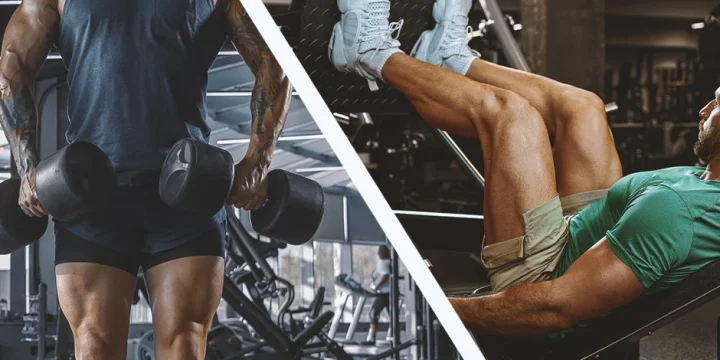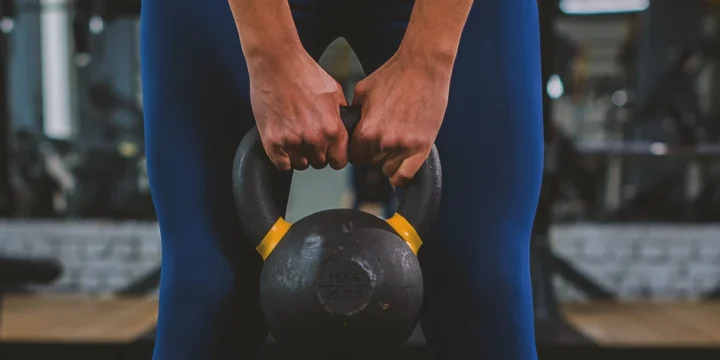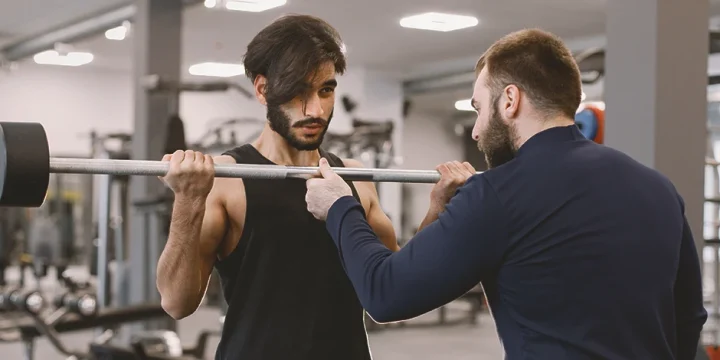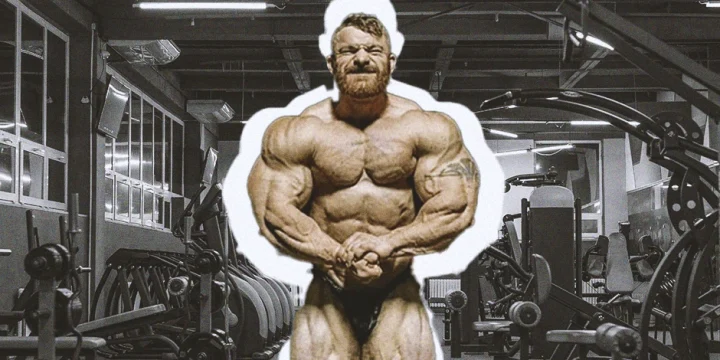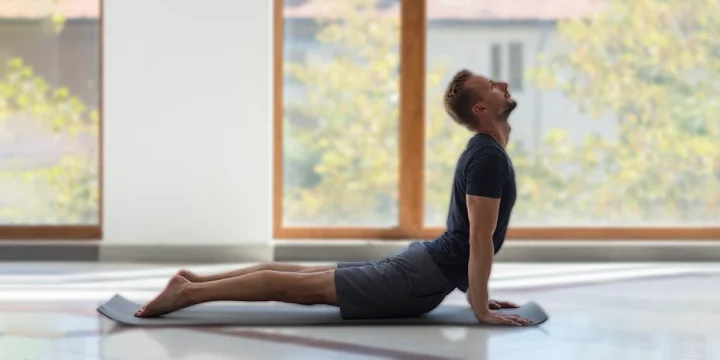Every muscle counts in bodybuilding, from big arms and blow-up pecs to having a broader chest.
If you want a festive and strong lower back, you need to train it with the same attention you would give any other muscle group.
As a professional coach with 9+ years of experience, I will provide you with the best exercises you can perform to develop a more considerable lower back.
Quick Summary
- The 12 best lower back exercises for bodybuilding include bent-over rows, good mornings, rack pulls, single-leg Romanian deadlift, back extensions, single arm dumbbell row, stiff-legged deadlift, stability ball reverse hyperextension, bird dogs, Jefferson curl, kettlebell swings, and superman.
- These exercises target the erector spinae muscles and the lumbar vertebrae, crucial for strengthening the lower back and enhancing overall bodybuilding performance.
- The human lower back is composed of essential muscle groups and five lumbar vertebrae (L1-L5), as outlined by the National Library of Medicine.
- From my perspective, focusing on these exercises can significantly enhance a bodybuilder's lower back strength, which is fundamental for a well-rounded and powerful physique.
The Best Lower Back Exercises for Bodybuilding

1. Bent-over Rows
The bent-over row, called the barbell row, is a classic activity in most muscle-building regimens.
In my experience, the bent-over row has been a game-changer for my back workouts. It not only targets my back but also engages biceps and core, making it a comprehensive upper-body exercise.
Bent-over rows are integral in powerlifting and strength training, targeting key muscles like the trapezius, latissimus dorsi, and rhomboids.
This exercise also engages the lower back, core, and arms, contributing to overall strength and power development in fundamental movements.
How to perform:
- Adopt a standing stance and use a double overhand grip to grasp the bar.
- Hinge until your torso is nearly parallel to (or slightly above) the ground. Begin the exercise by pushing the elbows behind your body while lowering the shoulder blades.
- Lift the bar till it hits your belly button, then carefully drop it back to its starting position under control.
- Repeat for reps.
2. Good Mornings
The dumbbell good morning is an excellent workout for the hamstring, lower back, and glutes.
An alternative should be performed if shoulder flexibility or back discomfort issues.
Good mornings must be learned with lesser weights before raising the range of motion and intensity.
It's a terrific workout for strengthening and building the entire posterior chain muscle mass and power once mastered.
How to perform:
- Go underneath a weighted barbell in a power rack.
- Set up like you'd do for a back squat and take a few steps backward.
- With your knees slightly bent, hinge at the hips while maintaining your shoulders down and chest up until your upper body is nearly parallel to the floor.
- Reverse the lift by squeezing your hamstrings and glutes until you're back standing.
- Repeat for the desired number of reps.
Also Read: Best Morning Stretches for Men
3. Rack Pulls
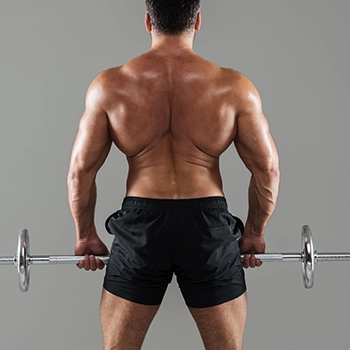
Rack pulls, a deadlift variation, effectively work the entire erector spinae group along with the lower, mid, and upper back.
This exercise involves a shorter range of motion, starting with the barbell positioned above or just below the knee, which makes it easier to maintain a neutral spine.
With this deadlift variant, you may raise a greater weight, which can adapt your body to lifting heavier weights to develop your strength along the posterior chain muscles.
From my coaching experience, rack pulls are excellent for clients who struggle with full deadlifts. They target the entire back and are perfect for those working on their form, thanks to the reduced range of motion.
How to perform:
- Place the barbell in the squat rack below or above the knees.
- Take your usual deadlift posture and grip.
- Hinge down and grasp the bar with an overhand shoulder-width grip, squeezing your armpits together as you draw up till lockout, finishing with the glutes.
- Return to your starting position.
- Repeat for the desired number of reps.
Related: Back Attack Workout for a Chiseled Upper Body
4. Single-leg Romanian Deadlift
"The Romanian deadlift is beneficial for back strength. Consider the bent-over row: you wouldn't perform it with 200kg, but you could execute a Romanian deadlift with that weight."
- David Kingsbury, Head Trainer at Opus Fitness
Every excellent workout should include a single-leg (or single-arm) movement.
Unilateral exercise helps discover, attack, and correct muscle strength or size imbalances.
Perform the single-leg Romanian deadlift to strengthen your lower back.
How to perform:
- Hold a bar while standing straight and move the bulk of your body weight to one of your feet.
- From here, gradually tilt into a hip hinge while lifting your non-working foot off the floor.
- When you tip over, the non-working foot should be relatively straight and fall behind you.
- Reverse the movement and stand up once you feel significant stretching in the muscle groups of your working leg.
- Repeat for reps.
5. Back Extensions
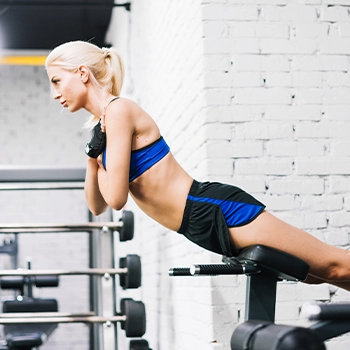
Back extensions are performed by flexing your lower lower back to drop and raise your torso while lying on a hyperextension bench or a back extension machine.
You may do this exercise using only your body weight or load the motion with a barbell, dumbbell, or weight plate.
Tempo training, which involves performing slow repetitions, can also stimulate muscular growth in your lower back.
In my training sessions, back extensions have been vital for strengthening the lower back, especially when we focus on controlled movements to maximize muscle engagement.
How to perform:
- Lay on a hyperextension bench, face down.
- Ensure the upper thighs are flat on the broad pad, with enough space to bend at the waistline.
- Cross your hands before you, keeping your body straight (or you can place them behind your head).
- Begin to bend forward progressively at the midsection as far as possible while keeping your back flat.
- Go forward without curving your back until you feel a good stretch in your hamstrings, and you can't go any farther without rounding the back.
- Gently return your torso to the starting position without bending your back.
- Repeat for the desired number of reps.
6. Single Arm Dumbbell Row
Like the barbell rows, this exercise generates a considerably fuller contraction across a broader range of motion.
This is also an excellent method to isolate and concentrate on each part of your back, relaxing one while working the other.
How to perform:
- Kneel on a bench, using your free hand to support yourself.
- Adjust your posture so that your body is parallel to the ground.
- Let the dumbbell dangle from your outstretched arm.
- Pull the weight to the chest, palms facing the body, and elbows firmly tucked in.
- Release the load and slowly extend your arm.
- The degree and intensity of this lower back exercise may vary depending on your body angle, grip, and weight.
7. Stiff-legged Deadlift
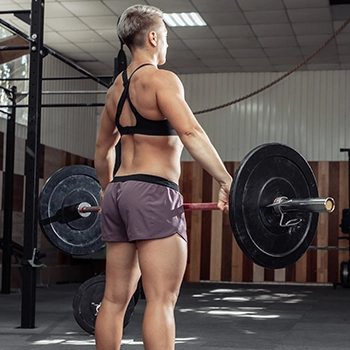
The deadlift is an excellent variant for pulling strength, but it can be modified to emphasize the lower back even more.
Stiff-legged deadlifts exclude your legs almost entirely from the equation, allowing you to focus on strengthening your lower back.
Stiff-legged puts a lot of mechanical force on your lower back without needing super-heavy weights. It also improves hamstring and hip flexibility and provides a broader range of motion.
As a coach, I've found stiff-legged deadlifts to be incredibly effective for isolating the lower back, making it a go-to for clients looking to increase lower back strength without overly involving the legs.
How to perform:
- Set up as you would for a conventional deadlift, with your legs under the hips, back flat, and arms on the bar slightly outside your thighs.
- Extend your legs before lifting to raise your hips till your body is parallel to the ground.
- Do a deadlift from here. Slowly lower the weight from a standing posture, focusing on tipping over at the waistline.
- Your hips should generally remain at the same level the entire time.
8. Stability Ball Reverse Hyperextension
If your gym does not have a glute hamstring raise (GHR) machine, the stability ball reverse hyperextension is a terrific alternative and a perfect regression if you cannot execute the GHR.
This exercise targets similar muscle groups with an added challenge due to the unstable surface, requiring careful attention to form.
The unique range of motion and sustained effort can lead to enhanced muscle growth and endurance.
How to perform:
- Put a stability ball on the weight bench, then sit on it with your stomach and hips slightly off it.
- Take a tight grip on either side of the bench and lift your legs off the floor until your glutes are fully tensed.
- Lower them slowly until your toes contact the ground.
- Reset and repeat for reps.
9. Bird Dogs
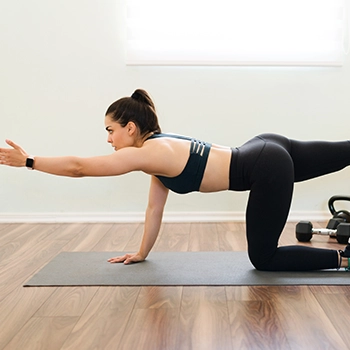
Though seemingly simple, the bird dog is a key exercise often performed incorrectly.
Done properly, it strengthens the core and lower back by requiring balance during the alternating movement of opposite limbs. Slow, controlled movement in this exercise is crucial for enhancing spinal stability, ultimately preparing your lower back for handling heavier loads.
From personal coaching experience, the bird dog is a staple for core and lower back strength. It's a simple yet effective exercise that, when done correctly, offers significant benefits for stability.
How to perform:
- Kneel on the ground in a six-point stance (knees, hands, and toes on the floor), with your knees under the hips and your hands precisely beneath your shoulders.
- Throughout the exercise, keep your back in a neutral position.
- Lift your opposite leg and arm straight out, maintaining a solid core and a horizontal line from head to toe.
- Return to your starting position and complete all repetitions on one or both sides.
10. Jefferson Curl
If you want to strengthen and build your lower back, you'll need to become used to some lower back mobility under stress. Spinal flexion, contrary to common assumption, is not inherently dangerous.
Most athletes aren't used to training in or out of lumbar flexion. As a result, a workout like the Jefferson curl is effective in stimulating specific muscles. You'll have to go slowly and prioritize solid form.
How to perform:
- Begin by standing straight with an unloaded barbell or something lighter (such as a PVC pipe).
- Start the Jefferson curl by curling your upper back over.
- The bar or pipe should start to make its way down your thighs.
- Continue curving your back until you feel a big stretch in the hamstrings or the barbell touches the floor.
- From top to bottom, your spine must be flexed.
- Resume to a standing posture by reversing the process, slowly and carefully unfurling your spine.
- Repeat for reps.
11. Kettlebell Swings

Kettlebell swings are straightforward to master and perform and benefit a wide range of muscle groups.
In addition to enhancing the lower back muscles, it works the abs, glutes, pecs, and quads, making it a great all-around erector spinae exercise.
Incorporating kettlebell swings into my training regime has been transformative. They not only enhance lower back strength but also work the abs, glutes, and quads, offering a full-body workout.
How to perform:
- Choose your preferred weighted kettlebell.
- Hold the kettlebell with both hands, slightly in front and between your legs. Set your feet shoulder-width apart.
- Swing the kettlebell back between your feet to generate momentum, then forward and upward to shoulder width with your knees slightly bent.
- Maintain a tiny bend in your feet as the bell rises while pressing your hips forward.
- Let the kettlebell return to its starting position.
- Repeat for the desired number of reps.
12. Superman
The superman is an excellent bodyweight exercise for preventing low back problems, improving posture, and developing a more vital mind-muscle link to your glutes and lower back.
The erector spinae is trained as an extensor by letting you lift your arms and legs off the ground while flexing the lower back and retaining this position.
Your lower back ought to work hard to commence the motion and stabilize to maintain the top isometric posture.
This is a lower back isolation exercise that anybody can do.
How to perform:
- Lie face down on a workout mat, forehead firmly on the floor, arms and legs extended.
- Lift your feet and hands 4 - 5 inches off the ground while maintaining your tummy flat.
- Maintain this lifted stance for three seconds before carefully lowering your feet and hands to the floor.
- Repeat for the desired number of reps.
Anatomy of the Lower Back
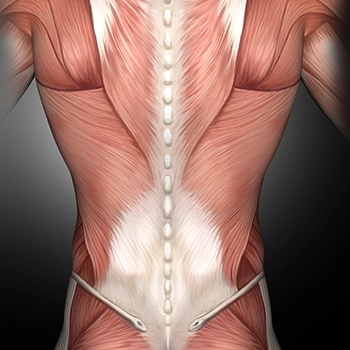
Your lower back comprises many essential muscle groups and five lumbar vertebrae (L1-L5), according to the National Library of Medicine [1].
Understanding the anatomy of the lower back, including the key muscle groups and the lumbar vertebrae, has been a cornerstone in my coaching approach. It's vital to grasp this to maintain a healthy back and enhance lifting performance.
Here's a summary of the anatomical structure of the lower back.
The Erector Spinae Muscles
Three muscles constitute the erector spinae column.
The erector spinae goes from the lower back and hips to the cervical (neck) spine and is placed laterally and posteriorly to the spinal column.
According to the The Journal of Physiology, the erector spinae are tenderloin-like muscles that run vertically alongside the spine [2].
The three muscles are:
- Spinalis: The spinalis muscle is the smallest and closest to the spinal column. Its tasks include rotating side to side and assisting with head control when looking up.
- Iliocostalis: The Iliocostalis is the most distant from the spine and originates at the sacrum. It enables spinal extension and lateral flexion.
- Longissimus dorsi: This is the middle and biggest of the muscles. Its functions include lateral extension and flexion of the spine and the ability to swivel your head in both directions.
Vertebrae
The lower back area has 5 vertebrae, denoted L1-L5.
The lumbar vertebrae form a lordotic curvature and have the most significant bodies in the spine. Its bigger shape reflects the lumbar spine's role in supporting the upper body.
L1-L5 allows lateral flexion, extension, and flexion, but not rotation [3].
Related Articles:
Benefits of Training Your Lower Back

From my coaching experience, training the lower back not only strengthens those small muscles but also plays a crucial role in injury prevention and assists in overall muscular performance.
To maximize the effectiveness of your workouts, cultivate a strong mind-muscle connection. This involves focusing your attention on the muscle being worked, which can lead to more effective training sessions and better muscle engagement.
Here are some more advantages of lower back training:
1. Injury Prevention
We'll start by emphasizing that you should visit your doctor immediately if you're experiencing lower back discomfort.
Lower back discomfort should not be treated with direct lower back exercise.
On the other hand, a muscular lower back may be more prepared for the normal physical stressors of everyday life.
Consider lower back training to be a (potential) pain-preventative measure.
2. Enhanced Lower Back Strength

The erector muscles are located along the spine.
They contribute to spinal stability by maintaining the spine neutral under stress and preventing unwanted motion.
This is useful not only for deadlifting and squatting but also for sprinting, jumping, and bending down to pick up something.
"Your spine and back muscles sustain your upper and lower body; without them, it would be quite weak. A strong back will thus aid in supporting your body and allowing you to perform better and more effectively."
- Benjamin West, Co-founder of 360 Athletic
3. Improved Posture
Sturdy spinal erectors are essential for maintaining excellent posture and a neutral spine during strongly loaded motions.
You may reverse some of the effects of sitting by training them.
That is, as long as you maintain your consistency.
Trainer Tips for Lower Back Exercises

In my years of coaching, I've learned the importance of carefully selecting and tailoring exercises for the lumbar spine, ensuring precision and effectiveness for optimal lower back conditioning.
Lower back conditioning is essential for excellent athletic performance, but you must get the "when" and "how" right.
Remember, muscle growth isn't just about lifting weights; it's also about giving your body time to recover. Emphasize the necessity of adequate rest and quality sleep, crucial for muscle repair and growth, in your bodybuilding regimen.
1. Warm Up
Lower back muscle training is essential for developing a healthy, muscular physique; however, too many people rush into heavy-load workouts without adequately preparing for the exercises.
Warm up your entire body before your back exercises to get the most out of your training routine.
2. For Hypertrophy
To bulk up your lower back, apply the same principles as with other muscles: gradual increase in tension and workload.
Be cautious not to overstrain with intense workouts.
Instead, aim for progressive overload by increasing reps and focusing on longer time under tension, effectively building your lower back strength.
3. For Stamina

Starting your workout with lower back exercises can be effective for spinal strength, but be mindful of its role in supporting many compound movements.
Overworking the lumbar spine, especially if you plan to do other major lifts in the same session, could be counterproductive.
A balanced approach is to begin with compound lifts that engage the muscles isometrically, followed by specific isolation exercises for the lower back later in your workout.
4. For Endurance
While other workouts frequently put your lower back to the test, improving endurance is simple.
Most compound lifts performed correctly will enhance your spine's capacity to maintain excellent posture for longer durations.
If you want to improve your lower back endurance, prioritize time under tension, typically seen in isometric workouts such as the bent-over row or plank.
FAQs
How Do Bodybuilders Train Lower Back?
Bodybuilders train their lower back by performing rack pulls, back extensions, bird dogs, deadlifts, and kettlebell swings that hit the lower back muscles.
What's the Best Exercise for Lower Back Muscles?
Barbell good mornings, swimmers, supermans, glute bridges, and cat-cows are some of the best exercises you can perform for lower back muscles.
What Are the 5 Exercises for Strengthening the Lower Back?
The 5 exercises for strengthening the lower back are the lower back twists, bridges, cat-cow movements, hamstring stretches, and drawing-in maneuvers.
References:
- https://www.ncbi.nlm.nih.gov/books/NBK537074/
- https://www.ncbi.nlm.nih.gov/pmc/articles/PMC1365926/
- https://www.ncbi.nlm.nih.gov/books/NBK459278/
About The Author
You May Also Like
